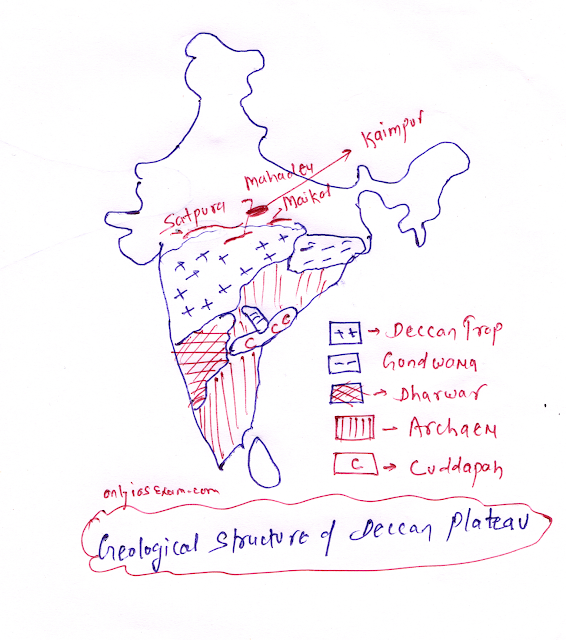Question.
Describe the geological structure of the Deccan Plateau. ( UPPSC, 2020, 15 Marks)
Answer.
The general meaning of geologic structure is the study of the distribution and types of rock on the surface and inside the surface.
The Peninsular Plateau is comprised of three Parts:
- Central Highlands[ Lying in North of Narmada River]
- Northeastern Plateau or Meghalaya Plateau
- Deccan Plateau[ Lying in South of Narmada river]
Location and boundaries of Deccan Plateau:
- Deccan Plateau is a triangular landmass that lies south of the Narmada river.
- Satpura Range, Mahadev hills, Kaimur, and Maikal Range are in northern side.
- Deccan Plateau's slope is higher in the west and slopes gently eastwards.
- The Western Ghats and the Eastern Ghats are the western and eastern borders of the decan plateau respectively.
Geological Structure of Deccan Plateau:
Geogolicaly structurally, the Deccan plateau can be divided into the following four parts and the same is explained in the diagram:
Archaean Rock[ 4.5 Billion to 2.5 Billion years]
- Archaean rocks are first formed on the earth and it is the oldest rock and has no sign of fossil.
- Archean rocks are found in Kerala, Tamil Nadu, Andhra Pradesh, and Telangana,
Dharwar Rocks[ 2.5 Billion to 1.8 Billion years]
- It is the earliest sedimentary rock.
- It is mainly found in Karnataka in the Deccan plateau.
- The presence of Dharwar rocks is also present in Madhya Pradesh, Jharkhand, Aravali, and Meghalaya.
Cuddapha Rocks[1.8 Billion to 540 million years]
- It is mainly found in the Nallamalai hills of Andhra Pradesh and Telangana.
Gondwana Rocks[ 400 Million to 200 Million years]:
- About 98 % of Indian rocks are found in Gondwana rocks.
- It spreads in the Mahanadi and Godawari regions of the Deccan plateau.
- It is also found in Chhotanagpur and Meghalaya plateau.
Deccan Trap[80 to 66 Million years]
- It is a basaltic volcanic origin.
- It spreads in Maharashtra, Gujarat, Madhya Pradesh, Karnataka, and Telangana.
You may like:


ConversionConversion EmoticonEmoticon